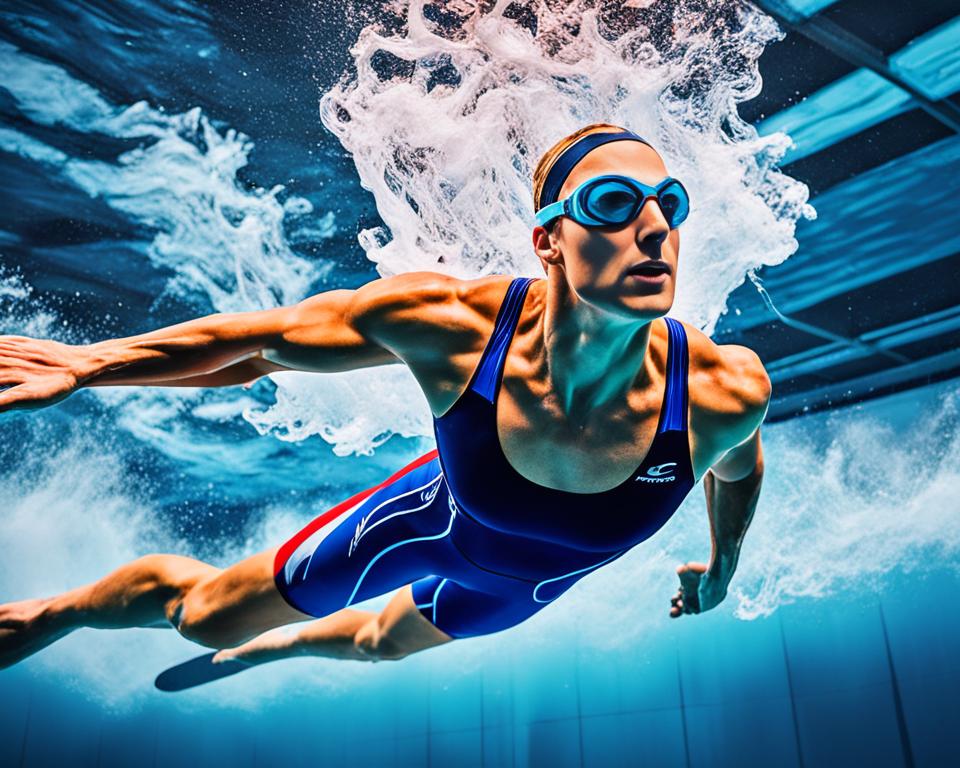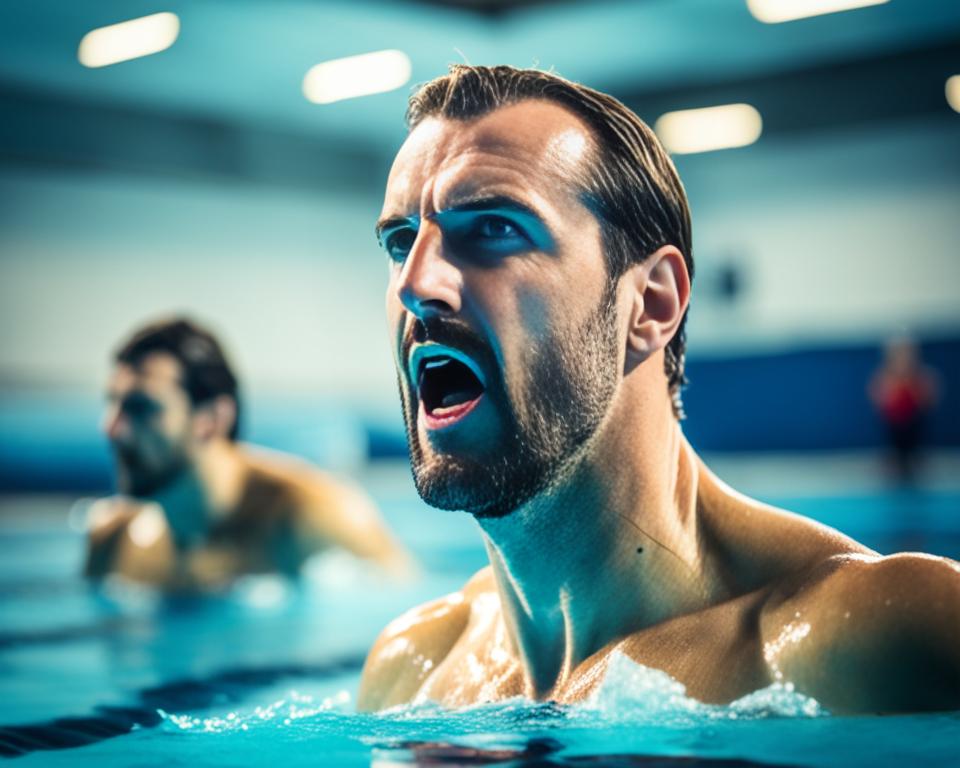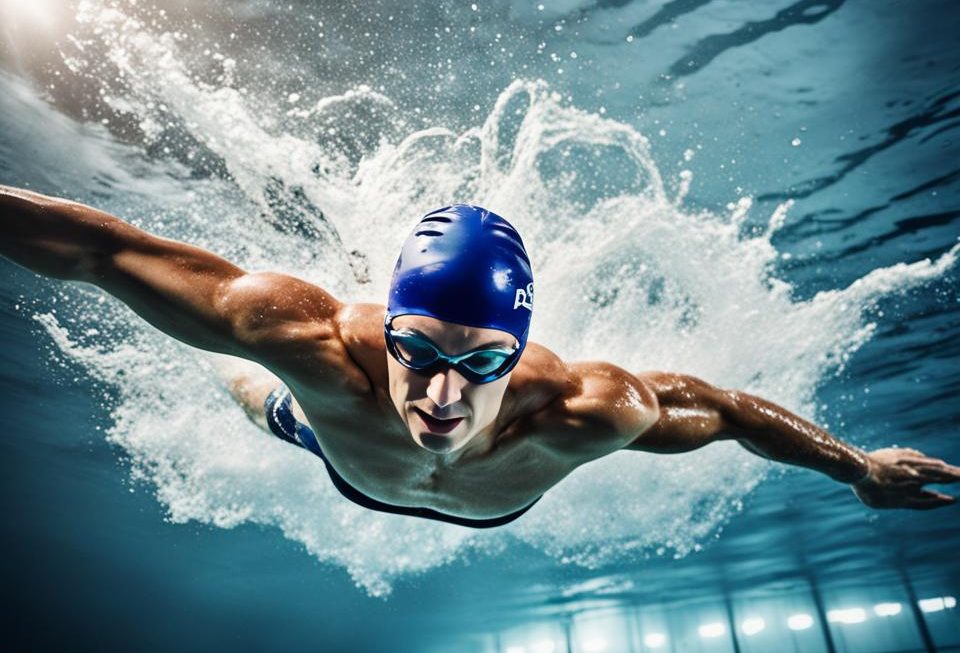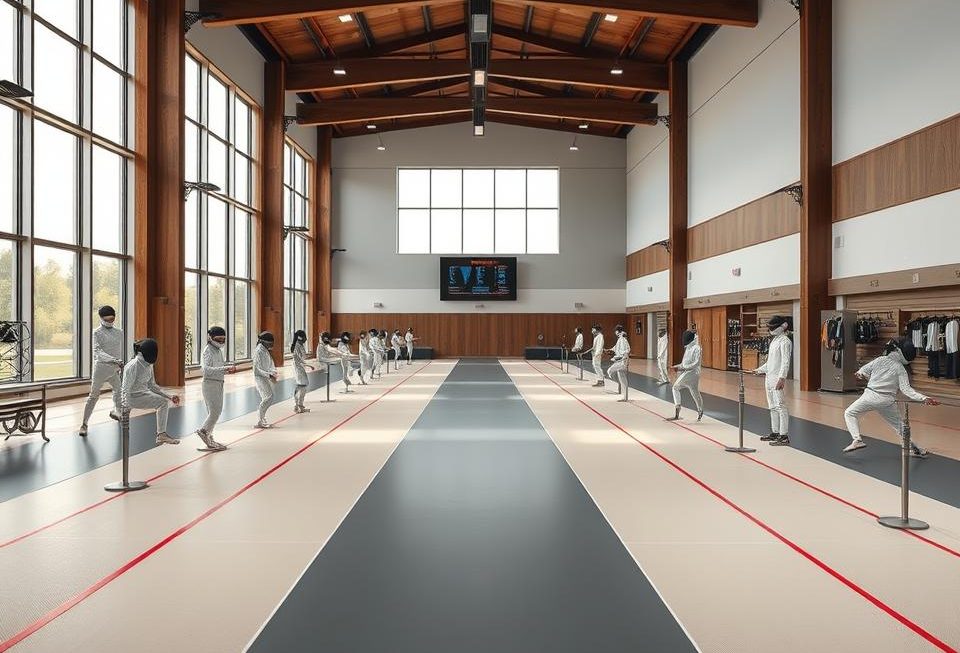Swimming is fascinating. It’s a sport where you need strength, skill, and a tough mind. This mix makes great swimmers stand out. They are deeply passionate, efficient in the water, and technically excellent. They push us to improve our swimming too.
This article will look at what makes a swimmer great. We’ll talk about the hard work and focus needed to be the best. By learning about these qualities, anyone who loves swimming can get better and understand the sport more.
Anyone who swims, whether just for fun or in competitions, will find useful information here. It will motivate you to learn more about being a top swimmer. So, let’s start and discover what makes the best swimmers the champions they are.
Read more interesting information at ::sportsnews1
Unwavering Passion for Swimming
Great swimmers have a deep passion for swimming. This love for the sport makes them work hard. They don’t give up, even when training gets tough or they face setbacks. They aim for the highest success in competitions.
The key is enjoying both training and competing. For them, it’s more than a duty; it’s a desire.
Cultivating a Lifelong Love for the Sport
For elite swimmers, swimming is everything. It’s more than just a hobby or a way to win medals. It’s a love they develop early and carry through their lives. This love is what makes them successful.
Finding Joy in Training and Competition
Good swimmers love pushing themselves to get better. They take pleasure in learning new skills. Trying to reach their best performance gives them energy.
“I don’t train to be the best. I train because I love what I do, and I can’t imagine my life without swimming.”
They build a strong passion for swimming. This keeps their love for the sport strong. They enjoy the hard work because they truly love what they do. This way of thinking is what leads them to success.
Superb Technique and Stroke Mechanics
Exceptional swimmers show their skill through technique and stroke mechanics. They swim with precise movements, cutting through the water smoothly and quickly. Their perfected body positions and strokes reduce resistance, making them efficient.
Great swimmers deeply understand how their body mechanics affect their performance. They focus on perfecting each stroke to increase their speed and strength. This attention to technique helps them make the most of their physical power in the pool.
A key skill for top swimmers is to keep a streamlined body shape during every stroke. This reduces water resistance, helping them swim with less effort. Understanding how to move efficiently in water is a big part of their success.
| Technique Element | Importance for Efficiency |
|---|---|
| Body Position | Maintaining a streamlined, hydrodynamic body shape to minimize drag and resistance in the water. |
| Stroke Mechanics | Executing each stroke with precision and coordination to maximize propulsive force and minimize energy expenditure. |
| Breathing Patterns | Integrating efficient breathing techniques to optimize oxygen intake and carbon dioxide expulsion during swimming. |
| Kick Dynamics | Developing a powerful, yet fluid kicking motion to contribute to overall propulsion and body stabilization. |
Mastering swimming technique and stroke mechanics helps elite swimmers reach their full potential. Their commitment to technical skill, along with their physical and mental strength, makes them champions in the water.
Exceptional Physical Endurance
Great swimmers stand out because they have amazing physical strength. They can keep up intense effort for a long time. This comes from hard training that works on their body’s aerobic and anaerobic capacities. They get stronger and sturdier, which helps them do really well in swimming contests.
Building Aerobic and Anaerobic Capacity
A swimmer needs to control their breathing and energy to swim far without stopping. To do this, they practice a lot in the pool. They take on difficult, long workouts that stress their body. They also train to be fast in short bursts of speed. This mix of training is the secret of the best swimmers. It helps them become super fit and stand out from others.
Embracing Grueling Training Regimens
To be a top swimmer, you must be ready for very hard workouts. Swimmers spend hours and hours in the pool. They improve their skills and stamina every day. They learn to love tough challenges, always aiming to get better!
Swimming champions are made from pure dedication and love for the sport. They train hard every day to build up their physical endurance. This makes them ready for any swimming event. With their hard work, they become the stars of the pool.
Mental Toughness and Resilience
Great swimmers have incredible mental strength and are very tough. They have a mindset that helps them through tough training and high-stress moments. Even after setbacks, they come back stronger.
Developing a Winning Mindset
Mental toughness is as important as being physically strong for these swimmers. They keep a positive and confident mindset during hard times. This mindset keeps them going, helps them over mental hurdles, and does their best in competition.
Bouncing Back from Setbacks
In swimming, being resilient is crucial. These top swimmers face many obstacles like injuries or bad days in training. Yet, they always find a way back. They see these challenges as chances to get better.
“Resilience is not about being unbreakable. It’s about having the strength to bounce back.”
By being tough and resilient, great swimmers push past obstacles and focus on their dreams. This helps them reach the top in swimming.
Hydrodynamic Efficiency
The key to a great swimmer’s speed and efficiency is mastering hydrodynamics. They make sure to have the best body position and streamlining. This way, they can move through the water easily, using less energy and going faster.
This skill is what makes elite swimmers stand out. They have perfected their technique to use less effort and swim faster.
Optimizing Body Position and Streamlining
Being hydrodynamically efficient means having a streamlined body position in the water. Swimmers keep their bodies aligned and extended. This reduces drag and helps them move forward smoothly.
Getting the body position just right is key. Even a tiny change can affect how well a swimmer moves. So, they always focus on their form and technique. Elite swimmers work hard to perfect their body position, aiming to cut down on any drag.
“The most successful swimmers are the ones who have mastered the art of gliding through the water with minimal resistance. It’s all about finding that sweet spot of hydrodynamic efficiency.”
Great swimmers spend a lot of time training to understand how their bodies and the water interact. They use these hydrodynamic principles to improve their speed and efficiency. This happens by maintaining a streamlined body shape.
| Hydrodynamic Factor | Impact on Swimming Performance |
|---|---|
| Body Positioning | Proper alignment and streamlining reduce drag, allowing for faster and more efficient movements through the water. |
| Arm and Leg Extension | Fully extended limbs create a more compact, hydrodynamic profile, minimizing resistance. |
| Head Placement | Keeping the head tucked in line with the body maintains a smooth, uninterrupted flow of water over the swimmer’s form. |
| Kick Technique | A powerful, streamlined kick generates propulsion while minimizing turbulence and splash. |
By truly understanding hydrodynamics, great swimmers use the water’s power to their advantage. By focusing on their body position and streamlining, they move through water faster and smoother than others. Their technique allows them to swim with amazing speed and style.
Mastery of Breathing Techniques
Great swimmers fully understand and use advanced breathing techniques. They know how to take in and let out air well. This helps them keep going strong without getting tired.
Using the right breathing techniques is important. It helps swimmers stay at their very best. They connect their breathing with their swimming strokes. This makes sure they use their air the best way they can.
Bilateral breathing is a key trick for top swimmers. It means breathing on both sides when they swim. This helps keep their air balanced. It stops too much carbon dioxide from building up. And that keeps them from getting tired too quickly.
Top swimmers also know how to breathe well under the water. They can control their breaths just right. This lets them have more air for their muscles. And that means they can swim faster and better.
“Mastering your breathing is the key to unlocking your full potential as a swimmer. It’s not just about taking in air – it’s about understanding the intricate relationship between your body, your stroke, and the water.”
Good swimmers make breathing a part of their whole swimming style. By being great at respiratory efficiency and oxygen management, they achieve more in swimming. This is how the world’s best swimmers shine.

Flexibility and Range of Motion
Top swimmers excel in flexibility and a broad range of motion. They build these skills through focused stretching and mobility exercises. This lets them swim with more power, less chance of getting hurt. Adding the right stretching to their workout plan is key for their fitness growth.
Incorporating Stretching and Mobility Exercises
Great swimmers know staying flexible and mobile is crucial. They work on their flexibility and range of motion through regular stretching and mobility exercises. Doing this helps their strokes get better, raises their power, and cuts down on injuries.
- Dynamic stretching routines help warm up the muscles and prepare the body for the demands of swimming.
- Static stretches target specific muscle groups, promoting increased flexibility and range of motion.
- Mobility exercises, such as arm circles and leg swings, improve joint mobility and overall body control.
- Foam rolling and other self-myofascial release techniques help reduce muscle tension and improve recovery.
For elite swimmers, including these stretching and mobility practices is a game-changer. It boosts their performance and lowers injury risks. In the fiercely competitive swimming world, this is a big deal.
“Flexibility is a key component of success in swimming. By maintaining a consistent stretching and mobility routine, I’m able to execute my strokes with greater efficiency and power, while also keeping my body healthy and resilient.”
– Michael Phelps, 23-time Olympic gold medalist
Commitment to Continuous Improvement
Great swimmers stand out because they always want to get better. They work hard to improve their skills, get more strong, and build tough minds. They think they can always grow, so they keep trying new things to be their best.
Success in swimming starts with being dedicated. It means they are always working on themselves, knowing even small changes can make a big difference. Their hard work drives them forward, helping them reach new goals in the sport.
- Constant Technique Refinement: Great swimmers are perpetual students of the sport, meticulously analyzing and fine-tuning their stroke mechanics to maximize efficiency and speed.
- Physical Adaptation and Evolution: They persistently challenge their bodies, adapting their training routines to build greater endurance, power, and agility.
- Strengthening Mental Resilience: Exceptional swimmers cultivate a robust mindset, able to overcome setbacks and maintain focus during the most demanding competitions.
“The journey of a thousand miles begins with a single step.” – Lao Tzu
Lao Tzu’s quote highlights how the best swimmers think. They know it takes time to be great, with lots of effort and learning. This way of thinking helps them become amazing, showing others the power of hard work and self-improvement.
| Trait | Description | Importance |
|---|---|---|
| Continuous Improvement | A relentless drive to refine skills, enhance physical abilities, and strengthen mental fortitude | Allows swimmers to consistently push the boundaries of their potential and achieve new levels of excellence |
| Dedication | A steadfast commitment to the arduous journey of self-improvement | Fuels the unwavering pursuit of excellence, enabling swimmers to overcome challenges and reach new heights |
| Growth Mindset | A belief in the ability to develop and improve through hard work and learning | Empowers swimmers to embrace setbacks as opportunities for growth, driving them to constantly evolve and excel |
Guidance from Skilled Coaching
Excellent swimmers know the value of skilled coaching. Coaches with experience offer targeted instruction and valuable feedback. They also create plans that are right for each swimmer.
Great swimmers turn advice into better performance. They learn and grow from what their coaches tell them.
Benefiting from Expert Instruction
Great coaches understand swimming down to the last detail. They use this knowledge to help swimmers get better. They focus on improving strokes, making swimmers more efficient, and expanding their skills.
With the help of these top coaches, swimmers can reach their peak. They keep getting better and better.
Implementing Constructive Feedback
Good coaches give constructive feedback to improve swimmers. They pinpoint what needs work and how to fix it. It’s crucial for athletes to take this advice and use it to grow.
The best swimmers see this feedback as a guide. They use it to fix mistakes, get stronger, and improve their game face.
| Coaching Quality | Impact on Swimmer Development |
|---|---|
| Skilled coaching | Provides targeted instruction, valuable feedback, and tailored training programs |
| Expert instruction | Refines technique, improves efficiency, and develops well-rounded skills |
| Constructive feedback | Identifies areas for improvement and offers tailored solutions |
Exceptional swimmers value the role that skilled coaching plays. Expert instruction and constructive feedback shape their journey to the top. By following seasoned pros’ advice, these athletes reach their full potential. They keep improving their swimming skills.

Balanced Lifestyle and Recovery
Elite swimmers know the value of a balanced lifestyle and recovery. They mix rest, active recovery, and wellness practices with their training. This mix helps them perform at their best all the time.
These swimmers take rest and regeneration seriously. They carefully plan their training to include enough recovery time. This stops burnout and helps their bodies grow stronger.
- Incorporate active recovery activities, such as light swimming, yoga, or stretching, to promote blood flow and muscle repair.
- Prioritize quality sleep, aiming for 7-9 hours per night to allow the body to fully recharge.
- Engage in relaxation techniques, like meditation or deep breathing, to manage stress and maintain mental clarity.
Elite swimmers take a full approach to their health. They eat well, drink enough water, and address any health problems. They cover physical and mental health with equal care.
| Recovery Strategies | Benefits |
|---|---|
| Adequate Sleep | Supports muscle recovery, boosts cognitive function, and enhances overall well-being. |
| Nutrition and Hydration | Provides the necessary nutrients and fluids to aid in recovery and maintain optimal performance. |
| Active Recovery Activities | Promotes blood flow, reduces muscle soreness, and improves flexibility and mobility. |
| Stress Management | Helps to mitigate the negative effects of physical and mental stress, supporting overall well-being. |
Elite swimmers keep a balanced lifestyle to improve. They use strategic recovery methods and holistic wellness. This shows their serious commitment to being the best they can be.
Embracing the Competitive Spirit
Great swimmers have a deep-rooted competitive spirit that pushes them to do better in tough situations. They love the excitement and pressure of competing. They turn their nervousness and energy into strong, focused actions. This skill, performing well when the competition is fierce, sets them apart.
Thriving in High-Pressure Situations
The top swimmers can keep their competitive spirit high and give their best even when things are tough. They’ve learned to be strong and calm when it really matters. This mental strength helps them stay focused on their goals.
These athletes know how crucial it is to enjoy competitive challenges and turn their spirit into success. They face high-pressure moments with excitement, using that energy to drive their success and reach new heights.
Elite swimmers have a mindset that loves competitive spirit and pressure situations. With this, they always perform their best under stress. They keep striving for success, even when the pressure is on. This makes them the world’s top swimmers.
| Trait | Importance |
|---|---|
| Competitive Spirit | Fuels the drive to excel in high-pressure situations |
| Mental Toughness | Enables swimmers to stay focused and calm under intense pressure |
| Resilience | Allows swimmers to bounce back from setbacks and maintain their competitive spirit |
“The true test of a champion is not whether he can triumph, but whether he can overcome obstacles. The true test of a champion is not whether he can triumph, but whether he can overcome obstacles.”
By embracing the competitive spirit and thriving in high-pressure situations, the world’s top swimmers keep impressing their fans. Their amazing performances don’t just win, they inspire.
Conclusion
Great swimmers show more than just swim skill. They have a deep love for swimming and a strong mind. They combine perfect techniques with endless energy and a drive to always get better. Knowing these traits helps all swimmers aim for the achievements of the top athletes.
This article has shown what makes a swimmer great. It includes love for swimming, perfect technique, and the willpower to keep going. By focusing on these, swimmers can be their best and reach new goals.
To truly succeed in swimming, one must be strong in all areas. This means being physically fit, skilled, mentally tough, and always looking to improve. By following this full-strategy, swimmers can move closer to their dreams in the sport.



